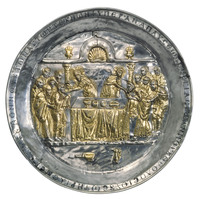Paten with the Communion of the Apostles
Type:
Liturgical objects,
Plates
Date:
565–78
Location or Findspot (Modern-Day Country):
Syria
Medium:
Gilt-silver,
Niello
Dimensions:
35 cm diameter
Description:
This paten is part of the Riha Treasure, which also comprises a chalice and fan. The objects may have been made in Constantinople, but the hoard was discovered at Riha, a village southwest of Aleppo (Syria). The Riha Treasure was most likely buried in response to Sasanian and Arab invasions during the early seventh century and then never retrieved. The paten can be dated by the stamps indicating it was manufactured during the reign of Justin II (r. 565–78). The Greek niello inscription reads, "For the repose [of the soul] of Sergia, [daughter] of John, and of Theodosios, and [for] the salvation of Megalos and Nonnous and their children."
The paten was designed to hold bread, and was used in conjunction with the chalice, which held wine. The Eucharist, part of the Christian liturgy, commemorates and repeats Christ's actions during the Last Supper, when he offered bread and wine as his body and blood. The repoussé scene on the paten is the Communion of the Apostles. Christ appears twice (identifiable by his cross-nimbus), fulfilling the dual roles of priest and deacon. He distributes bread and wine to the faithful, in this case the apostles who approach six per side. The table of the Last Supper has become an altar, and the conch in the background suggests the apse of a church. Other liturgical vessels are visible in the image, including a chalice and the pitcher and basin for ritual hand-washing. The imagery on the paten would have reminded its users that liturgical ritual reenacted biblical history.
The paten was designed to hold bread, and was used in conjunction with the chalice, which held wine. The Eucharist, part of the Christian liturgy, commemorates and repeats Christ's actions during the Last Supper, when he offered bread and wine as his body and blood. The repoussé scene on the paten is the Communion of the Apostles. Christ appears twice (identifiable by his cross-nimbus), fulfilling the dual roles of priest and deacon. He distributes bread and wine to the faithful, in this case the apostles who approach six per side. The table of the Last Supper has become an altar, and the conch in the background suggests the apse of a church. Other liturgical vessels are visible in the image, including a chalice and the pitcher and basin for ritual hand-washing. The imagery on the paten would have reminded its users that liturgical ritual reenacted biblical history.
Relevant Textbook Chapter(s):
3
Repository and Online Resources:
• The Riha Paten is now at Dumbarton Oaks.
Image Credits:
Dumbarton Oaks, Byzantine Collection, Washington, DC


